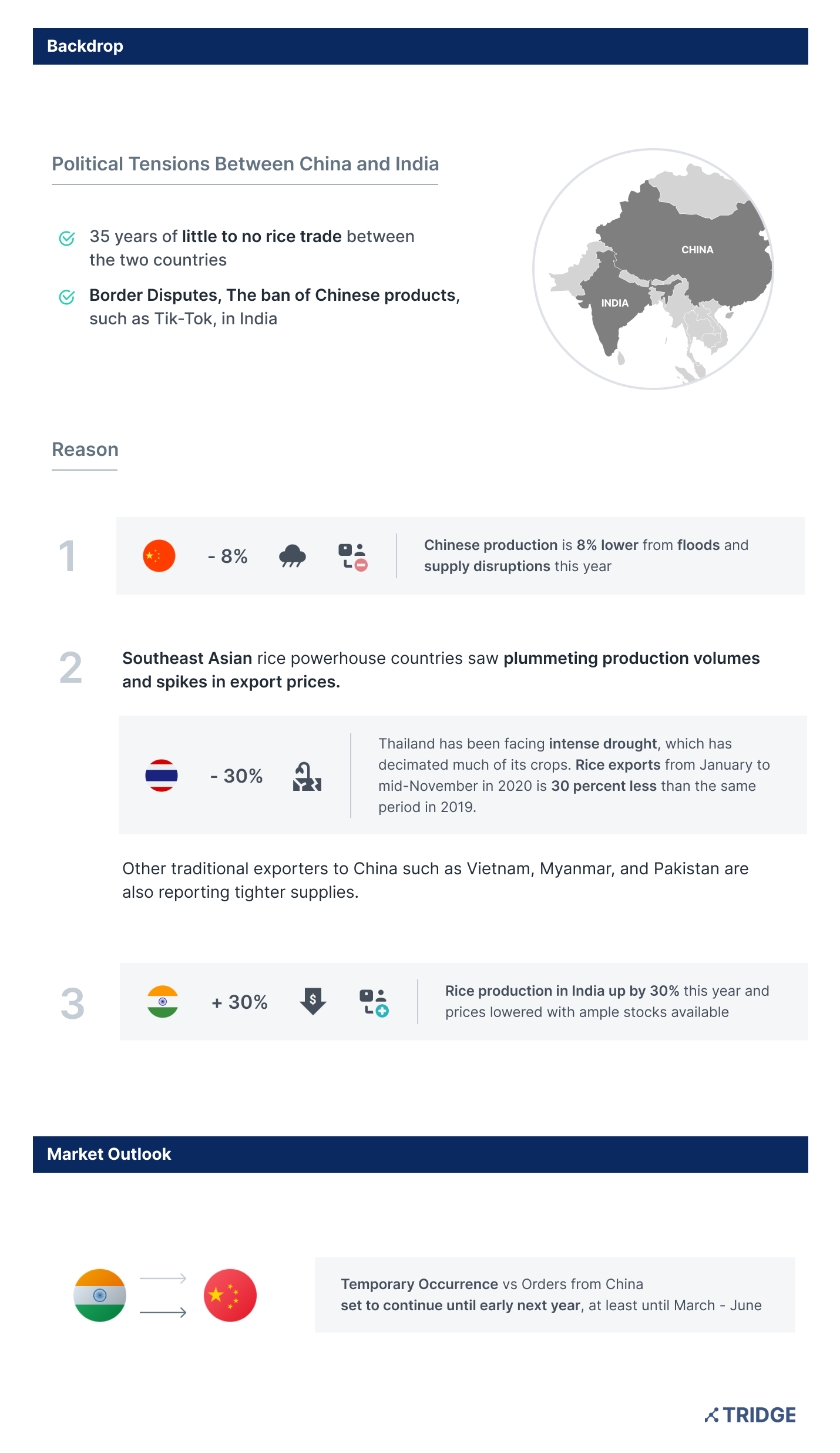China Imports Rice from India Amidst Growing Political Tensions
After 35 years of little to no rice trade between the two stronghold countries, India has resumed trade with China, where 100K tonnes of broken rice have been contracted to be shipped from December to February. Despite political tensions that have boiled to the point where India has implemented “anti-China” policies, China will buy from India as major rice suppliers: Thailand, Vietnam, Pakistan, and Myanmar have all cited major shortages in supply.
Deteriorating Trade Relations
India-China relations, which has had its history of disputes, reached its peak over the past few months over the two countries’ shared border. Disputes have ensued with multiple casualties, finger-pointing, and the ban of Chinese products, such as the famous app, Tik-Tok, in India. In 2019, Indian rice exports to China were at 722 tons of Semi-milled rice, as well as a mere 26 tons of Broken rice. The total export value of rice exports to China was at USD 434K, a small portion compared to the more than USD 6 billion in total export value for the country. Instead of China, Indian rice exports are mainly directed toward the Middle East - Iran, Saudi Arabia, Iraq, UAE, among others - with these countries in turn, having India as their main source of rice supplies.
Chinese Imports of Rice from India

*Period from previous December to February
*Numbers from 2019 an approximation, from 2021 the contracted amount
Data Source: ITC Trade Map
A Blow to the Southeast Asian Rice Industry
China, on the other hand, has been sourcing its rice predominantly from Southeast Asia, which comprises more than half of its rice imports. Thus the resumption of trade for rice has come as a surprise for many, especially as Indian rice imports have been minimal.
According to Tridge’s Regional Manager in India, Chayan Mukherjee, along with Chinese production being around 8% lower from floods and supply disruptions this year, the decision to import rice from India ultimately came after Southeast Asian rice powerhouse countries saw plummeting production volumes and spikes in export prices.
Thailand has been facing intense drought, which has decimated much of its crops. According to USDA reports, rice exports from January to mid-November in 2020 is 30 percent less than the same period in 2019. Production is 40 percent less in the MY 2019/20 off-season, in which most of the rice produced is destined for exports, compared to MY 2018/19. Other traditional exporters to China such as Vietnam, Myanmar, and Pakistan are also reporting tighter supplies, making India attractive for imports compared to other competitors that have been quoting at higher prices from the shortage. Rice production in India was up by 30% this year and prices were lowered with ample supply stocks available. Indian rice exports are currently priced at approximately USD 300 to 340 per metric ton, with even the high-quality IR 64 (parboiled) rice priced around USD 395 to USD 420 per metric ton.

Outlook for Early 2021
The question remains, however, of whether China will continue rice imports in the future even though it has agreed to source from India for the present. Much of it may depend on how fast major rice exporters are able to restore their supply levels, as well as the political scene between the two countries, especially as the border disputes have not yet been resolved.
Many are regarding this as a temporary occurrence spurring from a limited number of options this current season, with China expected to return to its traditional pool of suppliers once the shortage is resolved. Rice exporters in India, nevertheless, are of the opinion that orders from China are set to continue until early next year, at least four to seven months onward from December, with the possibility of it being more than a one-time occurrence.
Sources
- ITC Trade Map.
- Reuters. "China buys Indian rice for first time in decades amid scarce supply."
- BBC. "India-China Dispute: The border row explained in 400 words."
- USDA. Thailand Rice Price - Weekly.
- USDA. Thailand: The Impact of Drought on Agriculture in 2020.